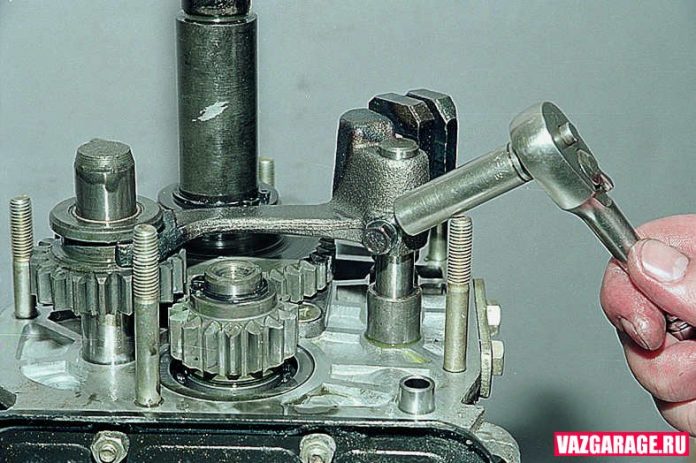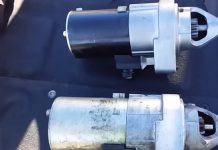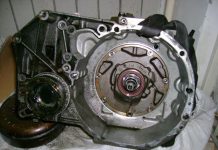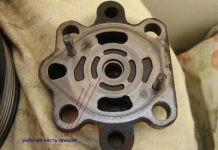In detail: do-it-yourself vase box repair from a real master for the site my.housecope.com.
When there are problems with the gearbox, it must be addressed immediately. If you start this process, you can lose the possibility of repairing the gearbox, and you will need to directly replace it.
DIY VAZ 2106 gearbox repair
Attention. The gearbox consists of a large number of parts, many of them are similar, therefore, to facilitate assembly, the parts should be laid out on sheets of paper in order and be sure to sign each one.
1. Drain the oil from the gearbox.
2. Remove the gearbox.
3. Remove the clutch release drive plug and the clutch release bearing.
4. Thoroughly clean it from dirt, wash the gearbox housing with a brush and hot water and detergent from the outside and place it on the workbench with the clutch housing down.
5. Use two screwdrivers to separate the sectors of the spacer sleeve and ...
6.… remove it and the rubber bushing of the damper.
7. Remove the flexible coupling and flange from the gearbox output shaft.
8. Using the "13" head, unscrew the two support fastening nuts.
10. Using the "10" head, unscrew the nut that secures the speedometer drive ...
11. ... and remove the speedometer drive.
12. Using the "22" key, turn off the reverse light switch ...
14. Using the "13" key, turn off the stop for shifting the gear shift lever.
15. Using the "13" head, unscrew the two nuts securing the bracket.
16. Remove the bracket and take out the square head bolt.
17. Using the "13" head, unscrew the remaining nuts securing the rear cover of the gearbox.
18. Remove the rear cover by moving the shift lever to the right to free it from the gear shift rods.
| Video (click to play). |
19. Carefully, trying not to damage, remove the back cover gasket.
20. Remove the rear bearing.
21. Remove the drive gear of the speedometer and its retainer - a steel ball.
22. Remove the reverse gear and reverse intermediate gear.
23. Remove the distance sleeve from the reverse gear rod.
24. With a puller, remove the retaining ring from the intermediate shaft.
25. Remove the reverse drive gear and spring washer.
26. With a puller, remove the retaining ring from the secondary shaft.
27. Remove the driven reverse gear and spring washer.
28. Using an impact screwdriver, unscrew the four screws securing the bearing lock plate and the axis of the intermediate reverse gear.
29. Remove the locking plate.
30. Take out the axis of the intermediate reverse gear.
31. Using the “10” head, unscrew ten nuts securing the bottom cover.
32. Remove the cover. We put the gearbox on its side.
33. Using the "13" head, unscrew one nut, ...
34. ... and the head "17" - six nuts securing the clutch housing to the gearbox.
35. Disconnect the crankcases and remove the gasket.
36. Using the "13" head, unscrew the two bolts securing the cover of the rod retainers.
37. Remove the cover and remove three springs and three balls from the holes.
38. Take out the rod of the reverse engagement fork.
39. Using the "10" head, unscrew the bolt securing the plug for engaging 1st and 2nd gears.
40. We take out the rods, at the same time removing the blocking crackers.
41. We take out the rod of the plug of inclusion of the 1st and 2nd gears.
42. Using the “10” head, unscrew the bolt securing the plug for engaging the III and IV gears.
43. We take out the rod of the plug of inclusion of III and IV gears.
44. By clicking on the couplings, we turn on two gears at once and with the key "19" unscrew the bolt securing the front bearing of the intermediate shaft.
45. Prying the retaining ring with two screwdrivers, take out the front bearing of the intermediate shaft.
46. We push out the rear bearing of the intermediate shaft.
47.Tilting, remove the intermediate shaft from the gearbox housing.
48. We take out two gear shift forks.
49. Prying with a screwdriver, take out the input shaft assembly with the bearing and the synchronizer ring.
50. Remove the needle bearing from the secondary shaft.
51. Prying with a screwdriver, remove the key from the back of the secondary shaft.
52. Prying off with two screwdrivers, remove the secondary shaft rear bearing.
53. We take out the secondary shaft from the gearbox housing.
54. Vertically install the secondary shaft, clamping it in a vice through cardboard spacers. Remove the synchronizer sleeve for III and IV gears.
55. Remove the retaining ring with a puller ...
56. ... and remove the synchronizer hub and spring washer.
57. Prying off with a screwdriver, remove the retaining ring, as well as the locking ring and the synchronizer spring.
58. We remove the gear wheel of the III transfer.
59. Leaning the gear wheel of the 1st gear on a hard base, knock out the secondary shaft with a hammer through a spacer made of soft metal ...
60. ... and remove from it the II gear assembly, the synchronizer coupling for the 1st and 2nd gears, the synchronizer hub, the 1st gear assembly and the 1st gear sleeve.
61. Elements of synchronizers I, II and IV (on the input shaft) gears are disassembled similarly to the synchronizer of III gear.
62. To remove the input shaft bearing with a puller, unclench the retaining ring ...
63. ... and remove it together with the spring washer.
64. Leaning the bearing on a rigid base, knock out the input shaft with a hammer through a drift from soft metal.
65. To remove the gear shift lever from the rear cover of the gearbox housing, disconnect the return spring from the lever.
66. Using the "10" wrench, unscrew the three nuts securing the ball joint of the lever and ...
67.… remove the lever from the studs.
68. To replace the cuff of the drive (primary) shaft, we knock out the cuff with a punch through the hole in the front cover of the gearbox and ...
We thoroughly wash all parts in kerosene or diesel fuel and inspect them. The teeth of gears and couplings should be free of chips, scoring, fatigue chipping and noticeable wear. The surfaces of shafts, axles and shift rods must be completely smooth, free from scoring, pits and severe wear. There should be no cracks or nicks on the crankcase, and there should be no wear or traces of turning in the bearing bores. Corrosion and traces of crushing and galling are unacceptable on the shaft splines. Minor damage can be repaired with fine sandpaper followed by polishing, but it is better to replace damaged parts with new ones.
All rolling bearings, both ball and roller, must be in perfect condition, their radial play must not exceed 0.05 mm, any defects on the tracks and rolling elements are unacceptable. Separators should not have breaks, touching rings and melting (for plastic ones). In general, if the "mileage" of the box exceeds 120 thousand km and the unit is being repaired with disassembly, it is better to replace all bearings with new ones, regardless of their condition, especially if severe damage to gears and gear clutches was noticed. We replace the cuffs with new ones in any case. When assembling, we lubricate all the parts of the box, incl. the bearing seats and the bearings themselves with transmission oil, the joints of the crankcase and covers are covered with a thin layer of oil-resistant sealant, and the parts of the switching mechanism are coated with SHRUS-4 grease.
We assemble the gearbox in the reverse order of disassembly. The spring of the reversing fork rod retainer is different from others in stiffness and has a black coating. Before installation, the working surface of the cuffs is coated with a thin layer of Litol-24 grease. We tighten the bolt of the intermediate shaft bearing clamping washer with a torque of 8.1–10.0 kgf.m. We tighten the nut of the rear end of the secondary shaft with a torque of 6.8–8.4 kgf.m.
We clean it from dirt and rinse the gearbox from the outside.
In the same way, remove the circlip from the secondary shaft bearing.
You can replace the hinge of the gear selector shaft on the gearbox installed on the vehicle.For clarity, we carry out this operation on the removed stock.
In the same way, we replace the outer ring of the input shaft bearing.
In the same way, we knock out the oil seal and the outer ring of the differential bearing from the gearbox housing. We take out the adjusting ring.
We clamp the input shaft in a vice with soft metal pads.
To disassemble the output shaft, we support the main gear drive gear on a wooden stand.
We insert a chisel or a powerful screwdriver into the gap between the end of the drive gear and the inner ring of the front bearing.
We clamp the secondary shaft in a vice with soft metal pads.
We clamp the driven gear of the final drive in a vice with soft jaws.
To remove the differential bearings, we clamp the box in a vice.
Detailed step-by-step instructions for disassembling and assembling the gearbox of a VAZ 2110 car and its repair. Watch the video and photos of the procedure.
When starting to disassemble the gearbox, it should be noted that if in the gearbox, when it was repaired, one of the parts was replaced: bearings or differential housing, clutch housing, then it is necessary to replace the adjusting ring of the differential bearings. And then start disassembling the box itself.
We disassembled and repaired the gearbox of the VAZ 2110 car.
1. Remove the gearbox from the machine, clean it from various dirt and wash it from the outside.
2. The pointer that shows the oil level must be removed from the gearbox.
3. Place the gearbox in an upright position on the clutch housing and unscrew the bolt numbered 1 with a flat washer, and two nuts numbered 3 with a spring washer that secure the clutch cable bracket. Remove this bracket from the gearbox by unscrewing all the bolts.
4. On the back cover, unscrew all the remaining fastening bolts (there are four of them).
5. Remove this cover. To do this, using a screwdriver, you need to raise the tide located on the lid.
6. The bolt with spring washer holding the fifth gear fork must be removed.
7. Then it is necessary to prevent the gearbox shafts from turning. To do this, they need to be fixed: the synchronizer sleeve and the fork must be moved down with the fifth gear engaged so that the gear and the coupling splines are connected, then turn on the third or fourth gear by moving the gear selection rod.
8. It is necessary to loosen the nut securing the input shaft and unscrew it. You have to try this because the nut is very tight.
9. Then do the same with the output shaft, as well as with the primary.
10. In fifth gear, lift the driven gear with screwdrivers (doing this, the synchronizer hub is pressed from the shaft). Together with the gear, it is necessary to remove the synchronizer and the output shaft plug. But it is imperative to make sure that the synchronizer sleeve does not move out and remains on the hub, since the balls that fix the synchronizer can crumble.
11. Remove the thrust plate from the top in the synchronizer, and then in the synchronizer itself in the groove of the coupling, get the fork.
12. The fifth gear and the locking ring (1) must also be removed from the synchroniser. It is necessary to number the blocking ring (1) and the coupling (2), and remove the ring. This must be done in order to put the ring in the same position as it was, because during operation the teeth of the coupling and the ring have already run in to each other. If there is no reason to disassemble the synchronizer, then it must be connected with something, so that it does not fall apart.
13. On the output shaft, remove the bushing.
14. There is a 5th gear drive gear on the input shaft. First you need to remove it and remember how it stood.
15. Remove the bearing plate (1). To do this, take an impact screwdriver and unscrew the four bolts with lock washers on the bearing plate mount. Remove thrust washer (2) on the output shaft.
16. Lift the two shafts by hand and remove the bearing circlip from them.
17.Unscrew the clips and remove the balls from there together with the springs.
18. Then unscrew the reverse lock, remove the O-ring, and remove the retainer spring.
19. Remove the retainer ball by tilting the box.
20. Unscrew twelve nuts and a bolt with spring washers on the fastening of the gearbox housings. Remember the place for the holder (1) and the eyelet (2). The process plug (3) must also be removed.
21. There are three special grooves along the crankcases. Insert a screwdriver there and disconnect the clutch housing from the gearbox housing.
22. Raising the gearbox housing, turn it to the left until the crankcase comes out from under the gear. Then remove the gearbox housing from the clutch housing.
24. Raising the shift rod for the first and second gears, watch when it comes out of the support (3), and then turn it to the left until the head (1) stops clinging to the locking bracket (2). Remove the rod with a fork; to do this, remove the rod fork (4) from the groove of the synchronizer coupling. If there is no need to remove the plug from the rods, then it is not necessary, as you can later confuse them.
25. The head of the shift rod of the third and fourth gears must be disconnected from the gear selection lever by turning the rod. Then raise the stem so that it does not have support, and remove the stem with the fork by pulling them out of the groove of the synchronizer coupling.
26. Remove the fifth gear engagement rod from the support by turning it and taking out the head, which was connected to the locking bracket.
27. Remove the idler reverse gear axle.
28. Remove the intermediate gear. To do this, you need to move the reverse idler gear to the gear selection mechanism, turn it 30-40 degrees and remove it from under the shaft gears.
29. Remove the primary and secondary shafts at the same time, slightly shaking them.
30. Remove the differential in the clutch housing.
31. On the mount in the gear selection mechanism, unscrew three bolts with spring washers and remove that mechanism.
32. Remove the magnet in the clutch housing.
33. On the housing of the speedometer drive with the driven gear, unscrew the nut and remove the housing itself. If the body o-ring has no elasticity or is torn, it must be replaced.
34. There is a metal sealing ring under the reversing light switch, so unscrew the switch. It is located in the gearbox housing.
35. Then press out the output shaft bearing with a special puller or screwdriver.
36. Remove the oil sump located under the bearing.
37. Press out the input shaft bearing with a special puller. If this is not available, then it is necessary to bend the wire in the shape of a hook, insert it into the groove of the crankcase and place the hook under the bearing. Using a screwdriver, press out the bearing from the crankcase, placing a wooden block under the screwdriver and knock on the screwdriver with a hammer, rearranging the hook in the grooves.
38. In the clutch housing, taking a suitable mandrel, press in the new front bearings to the stop.
39. Move the edge in the protective cover of the selector shaft using a screwdriver. Slide the lip together with the stem support sleeve.
40. Move the stem by unscrewing the bolt on the gear selector lever mount and remove this lever. Then remove the gear selector rod in the clutch housing.
41. If it is necessary to replace the stem hinge, it is necessary to move the protective cover on it and unscrew the bolt on the hinge fastening. For strength, TB-1324 glue was applied to the bolt. Therefore, before assembling, clean the bolt and apply this glue. If the protective cover in the stem hinge is frayed or not elastic, then it must be replaced.
42. Replace the clutch housing. To do this, remove the clutch release fork and bearing from the boat, then press out the oil seals.
43. In the clutch housing and gearbox, it is necessary to check all surfaces of the rear cover.If there is minor damage, they can be cleaned with sandpaper, and in case of significant damage, any part, such as cracks, chips, dents, should be replaced.
44. Then check the clutch housing and gearbox for integrity. In case of any defects, the crankcase must be replaced.
45. Check roller bearings. If the rollers, raceway or cage are damaged, then they must be replaced and installed on the shaft, taking into account that when measuring the radial clearance, its value should be no more than 0.07 mm. If there is play in the bearing, then it must also be replaced.
46. When checking the gear shift rods, replace them if they are bent, there are burrs or scuffs, the holes for the clips have worked out or there are irregularities. Also replace the forks if they are defective (for example, the legs are worn out or the forks are bent).
47. Check the seals of the axle shafts. If there are any tears, they look bad, the edge is uneven or with torn parts, with beads of rubber, the spring is stretched or broken, then the oil seals should be changed.
48. It is also worth checking and, if necessary, replacing the oil seal of the selector shaft and the oil seal of the input shaft.
49. When checking a magnet, if it is intact, then it is easy to clean it from dirt, and if there are small cracks or it already does not magnetise well, then it should be replaced.
50. The surfaces of the gearbox and clutch housings, as well as the rear cover, are very well cleaned of sealant.
51. The teeth of the gears must engage and be installed in the clutch housing, and then install the shafts.
52. When installing forks on the gear shift rods, you need to know: 1 - the stock together with the shift fork for the first and second gears, and 2 - the stock together with the shift fork for the third and fourth gears.
53. All parts that rotate must be well lubricated with gear oil.
54. Place the magnet in its place.
55. It is necessary to install the gearbox housing on the clutch housing, while it is imperative to lubricate all contacting surfaces with sealants for better connection with each other. Also lubricate the mating surfaces with sealants when connecting the rear cover to the transmission case.
Video on disassembling the VAZ 2109 gearbox:










